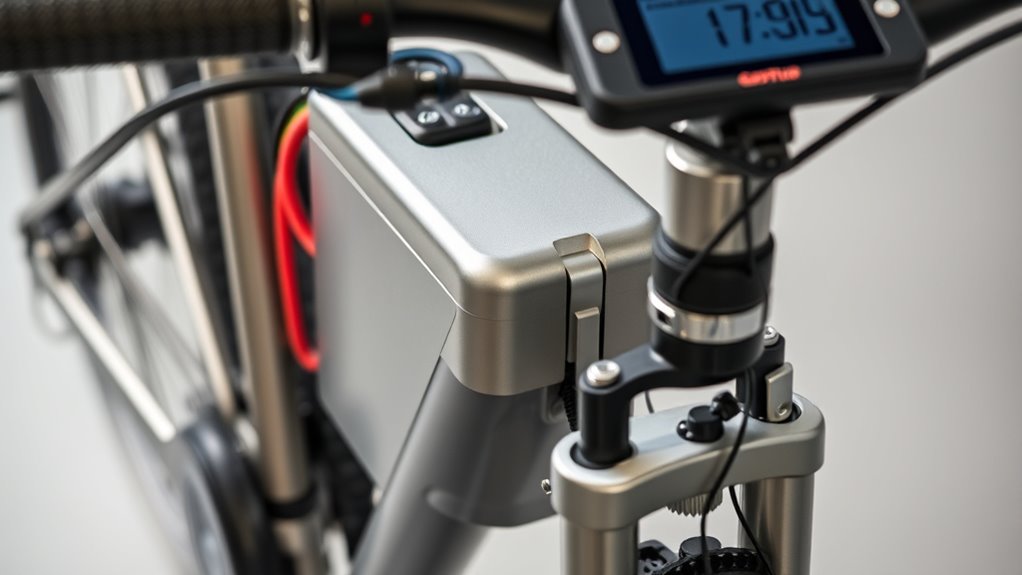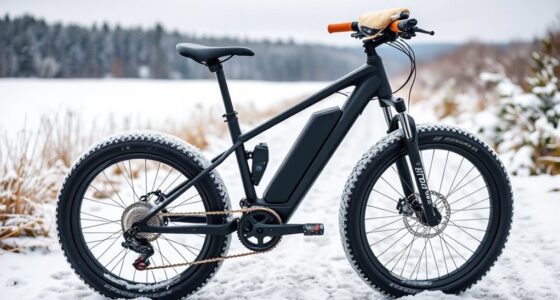An e-bike has key parts like the frame, suspension, drive system, battery, brakes, and display. Your frame choices affect weight and durability, while suspension improves comfort on rough terrain. The drive system, with hub or mid-drive motors and gears, powers your ride efficiently. Regularly maintain the battery for longevity and check brakes for safety. The display and controls let you monitor and customize your ride. Keep exploring these components to make certain your e-bike stays in top shape.
Key Takeaways
- An e-bike consists of key components such as the frame, suspension, drive system, battery, brakes, and control interfaces.
- Regular maintenance includes checking tire pressure, inspecting brakes, cleaning connections, and monitoring battery health.
- The drive system combines hub or mid-drive motors with gears to optimize power transfer and riding efficiency.
- Proper battery care involves avoiding full discharges, storing in cool places, and using manufacturer chargers.
- Safety features like disc brakes, lights, and helmets are essential for secure riding and require periodic inspection.
Frame and Suspension
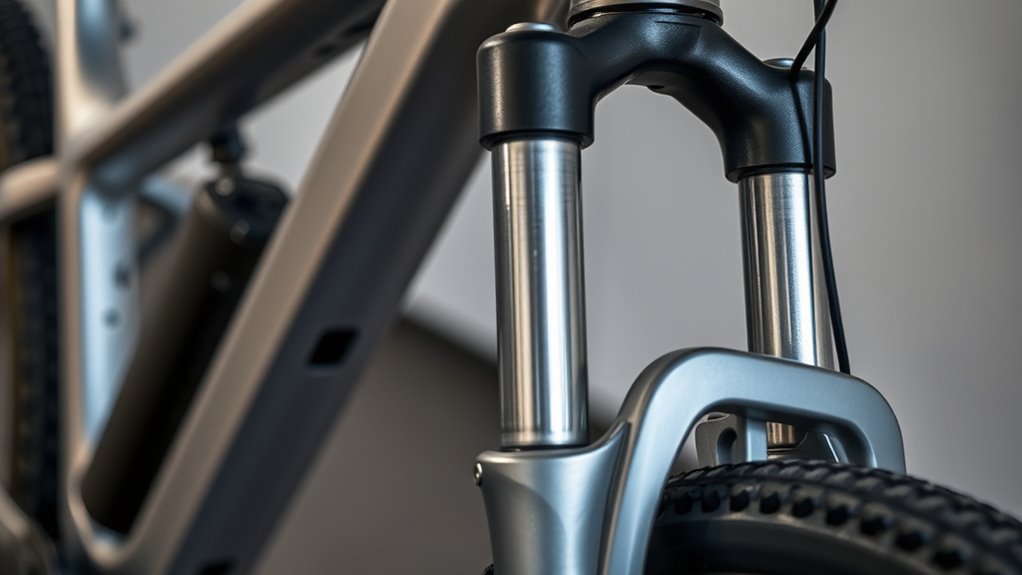
Have you ever wondered what makes an e-bike sturdy and comfortable to ride? It all starts with the frame material. Common options include aluminum, carbon fiber, and steel, each offering different balances of weight, strength, and cost. A lightweight frame makes handling easier, while a durable one guarantees longevity. Suspension types also play a key role in ride comfort. Front suspension absorbs shocks from bumps, while full suspension systems smooth out rough terrains by cushioning both front and rear wheels. The choice of suspension depends on where you plan to ride most. A well-designed frame combined with the right suspension system provides stability, comfort, and control, making your riding experience more enjoyable and less tiring. For e-bikes, Kia Tuning options can include customizations for enhanced performance and comfort.
Drive System and Gearing
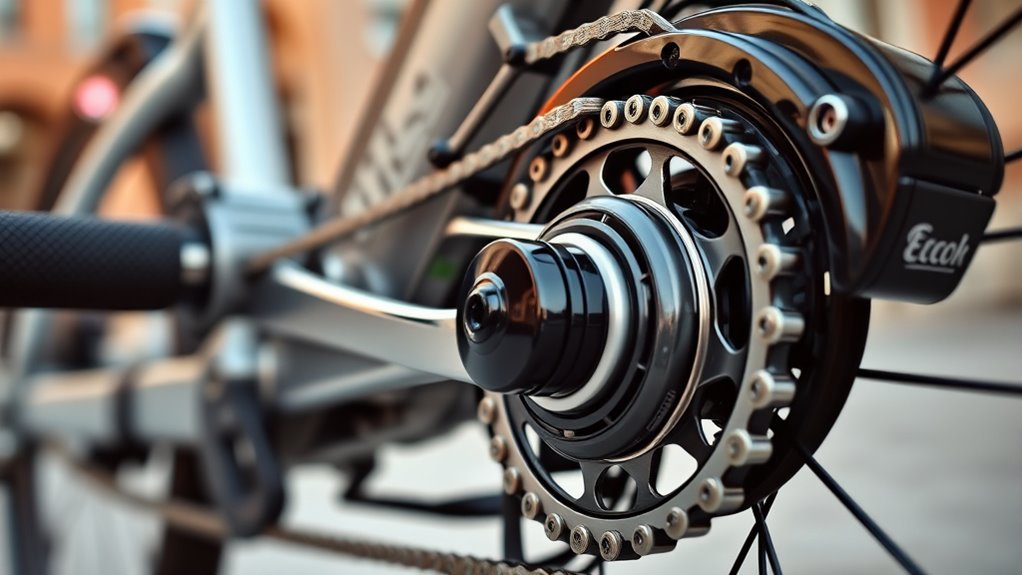
Ever wondered how an e-bike powers its ride and makes pedaling easier? The drive system combines motor types—like hub motors and mid-drive motors—that provide assistance, helping you pedal more efficiently. Hub motors are mounted in the wheel hub, offering simplicity, while mid-drive motors sit near the crank, delivering better torque and balance. Gear ratios play a *pivotal* role in how smoothly your bike climbs hills or accelerates; they determine how many pedal turns translate into wheel turns. Adjusting gears allows you to optimize power transfer and maintain a comfortable cadence. Understanding your drive system helps you choose the right settings for different terrains and riding styles, ensuring a smoother, more enjoyable experience every time you hit the road. Additionally, celebrity lifestyle insights can provide inspiration for customizing your own bike setup to match your personality and preferences.
Battery and Charging System
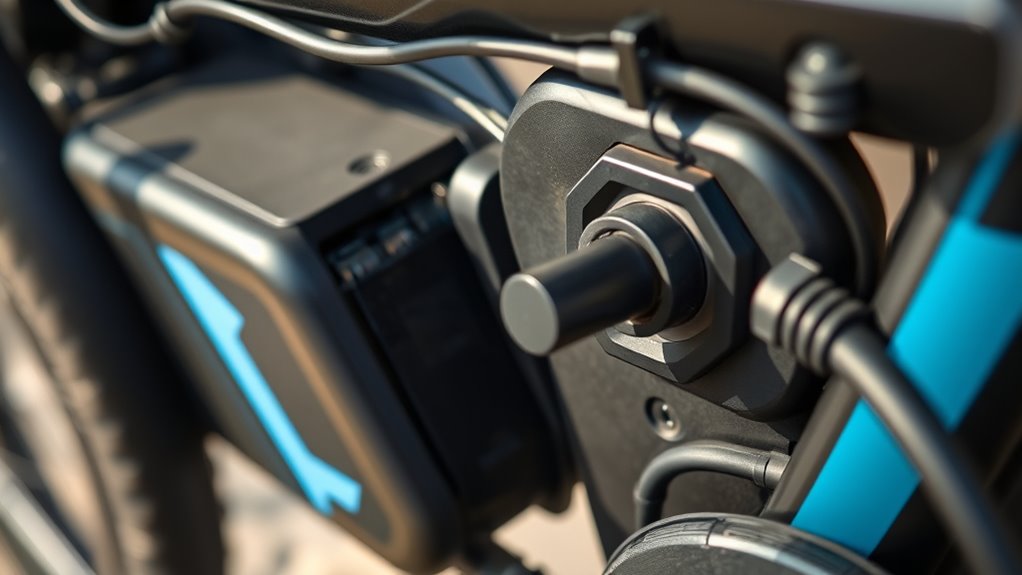
The drive system’s effectiveness depends heavily on the battery and charging system that powers it. Your battery’s longevity depends on proper care, like avoiding full discharges and storing it in a cool, dry place. Regularly check the connections and keep the battery clean to guarantee peak performance. When charging, always use the charger provided by the manufacturer to maintain charging safety and prevent potential hazards. Never leave the battery unattended while charging, and avoid overcharging, which can shorten battery life. Proper maintenance not only prolongs your battery’s lifespan but also keeps your e-bike running reliably. Additionally, understanding somatic therapy techniques can help you better manage stress and improve emotional well-being, which is essential for overall health. By following these simple steps, you’ll ensure your battery remains efficient and safe, providing dependable power whenever you need it.
Braking and Safety Features
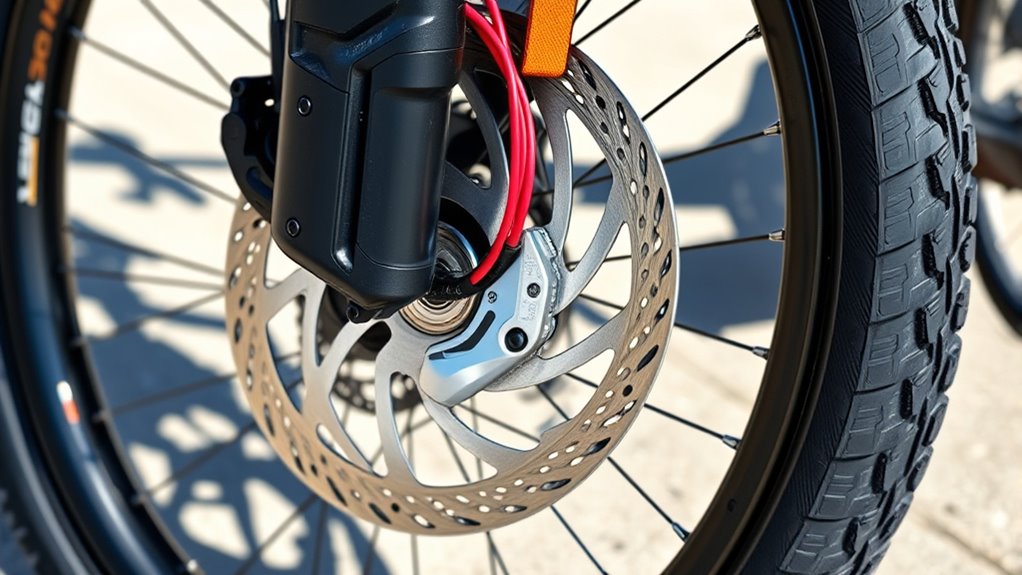
Effective braking and safety features are essential for guaranteeing your e-bike’s reliable performance and your personal safety. Modern braking technology, like disc brakes and regenerative braking, provides powerful, consistent stopping power in various conditions. These systems help you respond quickly to obstacles or sudden changes in terrain. Alongside advanced brake systems, wearing appropriate safety gear—such as a helmet, gloves, and reflective clothing—adds an extra layer of protection. Many e-bikes also include safety features like built-in lights, horn, and horn buttons to alert others. Regular maintenance of your brakes ensures they perform at their best when needed. The contrast ratio of your braking system can influence how quickly and effectively your e-bike comes to a stop under different conditions. Combining effective braking technology with proper safety gear helps you ride confidently and minimizes risks, making every ride safer and more enjoyable.
Display and Control Interfaces
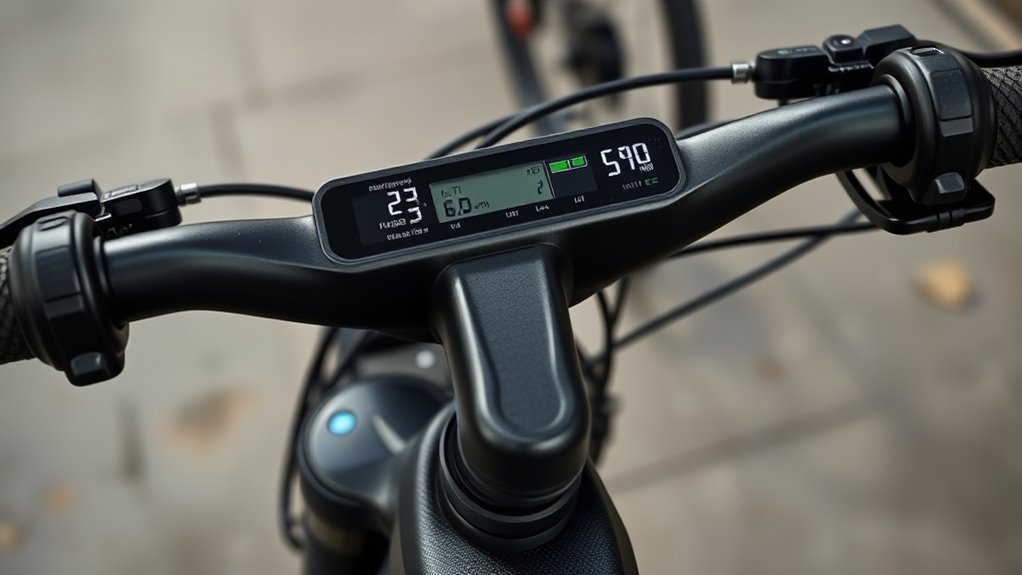
Display and control interfaces are the central hubs that allow you to monitor and manage your e-bike’s functions easily. The display screens provide critical information like speed, battery level, and riding mode at a glance. Control buttons are usually located on the handlebar or near the display, giving you quick access to switch modes, adjust assist levels, or turn lights on and off. These interfaces are designed for intuitive use, so you can focus on riding without distraction. Many e-bikes also feature customizable settings, allowing you to personalize your experience. By understanding how to operate the display screens and control buttons, you guarantee your e-bike performs at its best and that you stay informed during every ride. Proper use of these controls enhances safety and riding comfort. Additionally, familiarizing yourself with the display and control interfaces can help you optimize your e-bike’s performance and ensure a safer riding experience.
Frequently Asked Questions
How Do I Upgrade an E-Bike’S Motor or Battery?
When considering battery upgrades or motor enhancements for your e-bike, start by researching compatible parts with your model. You can upgrade your battery to extend range or boost power, and motor enhancements can improve speed and performance. Always check manufacturer guidelines and consult a professional if necessary. Proper installation guarantees safety and peak performance, so follow instructions carefully and consider professional help for complex upgrades.
What Are Common Signs of E-Bike Electrical System Failure?
When your e-bike acts up, it’s often a sign you’re chasing your tail. Look out for battery issues like sudden power loss or inconsistent assistance. Wiring problems can cause intermittent or no response from the motor. If your display flickers or the bike won’t turn on, those are clues. Regularly inspect connections and charge your battery properly—these simple checks help prevent electrical system failure and keep you riding smoothly.
How Often Should I Service the Internal Components?
You should service your e-bike’s internal components every 6 to 12 months. During this time, prioritize internal cleaning to remove dust and debris, which can cause overheating or damage. Also, perform a thorough component inspection to check for wear or corrosion. Regular maintenance ensures smooth operation and extends the lifespan of your e-bike’s electrical system, keeping everything functioning efficiently and preventing costly repairs down the line.
Can I Customize the E-Bike’S Software Settings?
Yes, you can generally customize your e-bike’s software settings through software customization options provided by the manufacturer. Many models allow you to adjust power modes, pedal assist levels, and display preferences. Keep in mind, firmware updates are essential for peak performance and new features. Always follow manufacturer guidelines for safe software customization, and guarantee your firmware is up to date to avoid compatibility issues.
What Safety Checks Are Recommended Before Each Ride?
You might wonder if you need safety checks before each ride. Investigating this, it’s true—pre-ride inspections are essential. You should start with a tire pressure check to guarantee proper inflation and check brakes, lights, and the chain for any issues. These simple steps help prevent accidents, keep your e-bike running smoothly, and ensure you’re safe on every ride. Always make time for these quick safety checks before hitting the road.
Conclusion
Now that you know the nuts and bolts of your e-bike, you’re ready to ride confidently and care for your trusty two-wheeler. Regular checks on the frame, drive, battery, brakes, and display will keep your bike running smoothly. Remember, maintenance maximizes performance and prolongs lifespan. So, stay savvy, stay sharp, and enjoy every exhilarating, eco-friendly adventure that your e-bike offers — because safe cycling starts with simple, smart service.
